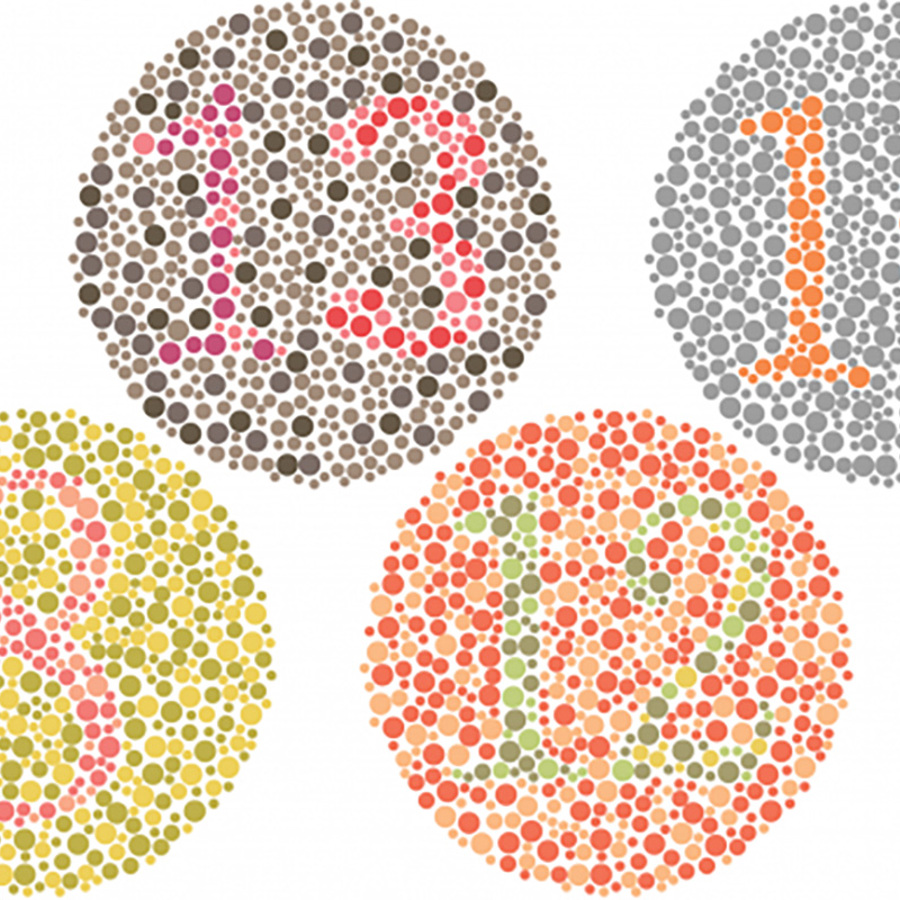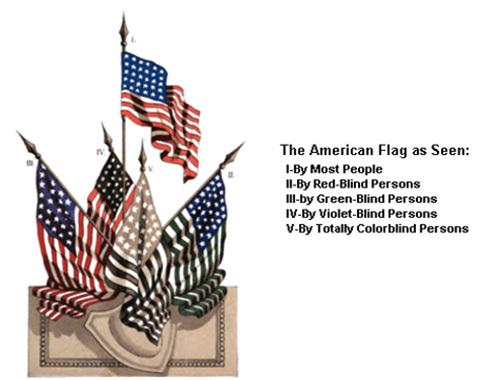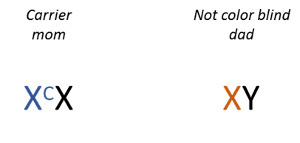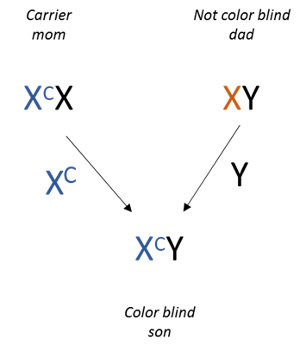
What are the chances of a color blind man having color blind grandchildren?
October 18, 2017

- Related Topics:
- Color vision deficiency,
- X linked inheritance,
- Carrier,
- Genetic conditions,
- Dominant and recessive
A curious adult from Maryland asks:
“Dad is color blind, mom isn’t. They have 2 daughters and both are not color blind. When the girls marry someone who isn’t color blind, will their kids be color blind?”
Each of the grandsons has around a 50% chance for being color blind. Most likely none of their granddaughters would be (although there is a chance the sons of these granddaughters, the great-grandsons, could be).
This is because both daughters are carriers. They have the bit of DNA that can lead to color blindness but they are not color blind themselves.
The reason they aren’t color blind but their sons are at risk has to do with where that bit of DNA is and how it works.
Three Things You Need to Know
OK let’s dive right in and see what is happening in your case.
The DNA that leads to red-green color blindness is on the X chromosome. Here are the three key things you need to know:
- Biological males usually have one X chromosome and one Y chromosome (XY)
- Biological females usually have two X chromosomes (XX)
- To be color blind, all your X’s have to have the color blind DNA
(At the end of the answer I have put a table where I put this all together so you can see the odds of having a color blind child with the six possible parent combinations.)

Your Case
So the father was color blind which means all of his X’s had the color blind DNA. We will show this like this:
XcY
He has an X and a Y. His X has a little “c” to show that it has the color blind DNA.
When he has a child, he will either pass his X or his Y down. If he passes the X, he will have a daughter and if he passes his Y, he will have a son.
This means that all his daughters inherited his Xc. Since neither daughter is color blind, their other X (from mom) must not have the color blind DNA. It is just an X:
XcX
If they had two X’s with the color blind DNA (XcXc), they’d be color blind too.
These daughters are carriers, they have one of each type of X. Let’s now see what can happen when they have kids with a man who is not color blind.
Here they each are:

To make things easier to follow, I have color coded the X’s. So mom has a blue one that can lead to color blindness (Xc) and a black one that can’t (X). And dad has an orange one that can’t lead to color blindness (X).
Remember that when they have kids, each parent will only pass down one chromosome from their pair.
Let’s say that mom happened to pass down her blue Xc and dad passed down his Y. Here is the combination their son would have:

He would have an Xc with DNA that can lead to color blindness and a Y. In other words all of his X’s would lead to color blindness. This is why he is most likely color blind.
Here are all four of the possible combinations:
- XcX Carrier, daughter
- XX Daughter
- XcY Color blind son
- XY Son
Each daughter has a 50% chance of being a carrier and each son has a 50% chance of being color blind.
The daughters who are carriers can have color blind sons with the same logic. If they have children with a man who is not color blind, then each daughter has a 50% chance of being a carrier and each son has a 50% chance of being color blind.
The daughters without that blue Xc will not have color blind sons.
Up until now I have only dealt with the situation where mom is a carrier and dad isn’t color blind. In the last section, I’ll give the odds for a color blind child with all six possible combinations of parents.
Every Genetic Combination
Here is a table with all the possible outcomes for the most common form of color blindness. It is a big table:
|
DAD |
MOM |
SON |
DAUGHTER |
||||
|
Color blind |
Carrier |
Not color blind, not a carrier |
Color blind |
Carrier |
Not color blind, not a carrier |
||
|
Color blind |
Color blind |
100% |
0% |
0% |
100% |
0% |
0% |
|
Color blind |
Carrier |
50% |
0% |
50% |
50% |
50% |
0% |
|
Color blind |
Not color blind |
0% |
0% |
100% |
0% |
100% |
0% |
|
Not color blind |
Color blind |
100% |
0% |
0% |
0% |
100% |
0% |
|
Not color blind |
Carrier |
50% |
0% |
50% |
0% |
50% |
50% |
|
Not color blind |
Not color blind |
0% |
0% |
100% |
0% |
0% |
100% |
Dad is in the first column and mom is in the second. Dad can’t be a carrier so he is either color blind (first three rows) or not color blind (last three rows).
The second column includes the three possibilities for mom—color blind, carrier and neither.
The way to use this is to find the row that describes the parents. Let’s say dad is color blind and you know mom is a carrier (more on that later).
In that case, you would look at the second row. There you can see that each son has a 50% chance for being color blind. Each daughter has a 50% chance for being color blind and a 50% chance for being a carrier.
Of course the tricky part in using this table is when mom isn’t color blind. In that case it can be hard to know if she is a carrier or not.
If she is not color blind but her dad is, then she for sure is a carrier (see the second and third rows). But if dad and/or mom aren’t color blind, it is hard to know which row applies to her.
At least for now, if you don't know if mom is a carrier or not, you just have to look at both possibilities and realize that at least one applies to her situation. Things might change if a "direct to consumer" genetic test becomes available that can determine if she is a carrier or not.
But until then, this is the best we can do.

Author: Dr. Barry Starr
Barry served as The Tech Geneticist from 2002-2018. He founded Ask-a-Geneticist, answered thousands of questions submitted by people from all around the world, and oversaw and edited all articles published during his tenure. AAG is part of the Stanford at The Tech program, which brings Stanford scientists to The Tech to answer questions for this site, as well as to run science activities with visitors at The Tech Interactive in downtown San Jose.
 Skip Navigation
Skip Navigation
